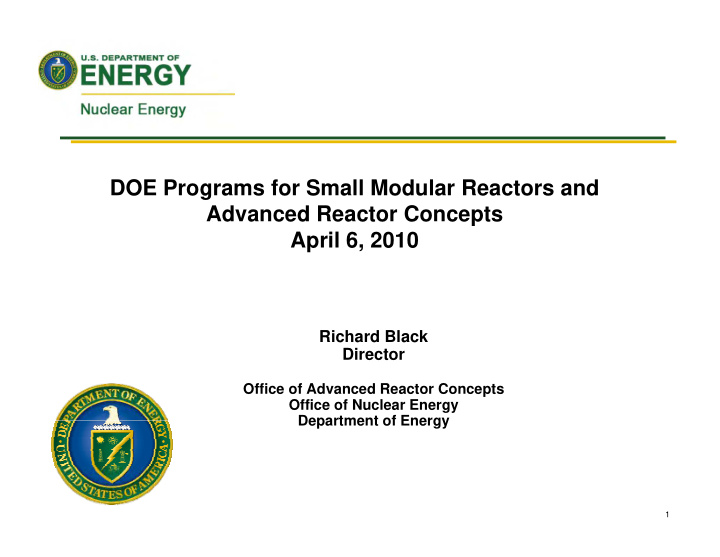



DOE Programs for Small Modular Reactors and Advanced Reactor Concepts April 6, 2010 Richard Black Director Office of Advanced Reactor Concepts Office of Nuclear Energy Department of Energy 1
Office of Advanced Reactor Concepts � Office of Advanced Reactor Concepts � New Office established in FY2011 � Responsible for both SMR and ARC, $22m SMR, $39m Advanced Reactor Concepts � FY2011 Budget Request for Advanced Reactor Concepts � ~$61M � Engage industry, NRC, federal and international organizations to establish NE Budget the appropriate DOE role to enable and $912m accelerate licensing and deployment of FY 2011 Budget Request SMR and Advanced Reactor technologies into the commercial markets. 2
SMRs and Advanced Reactor Designs and Concepts � SMR and advanced reactor designs and concepts can be grouped into three sets based on: � Design type � Estimated licensing and deployment schedule � Maturity of design � Three sets: � Light Water Reactor (LWR) evolutionary based designs � 5-10 years � Non-LWR designs � 10-15 years � Advanced (Transformational) Reactor Concepts and Technologies � 15-25+ years Note: DOE currently defines SMRs as those reactor designs that are ≤ 300MWe, and fabricated in modules that are transportable from the factory to the site by rail, truck, or barge. 3
SMR/ARC Program Focus Areas � Focus areas for RD&D based on estimated deployment schedules for reactor types: � 5-10 Year � Cost-share partnership with LWR SMR designs where near-term NRC licensing can be completed. � 10-15 Year � Engage industry, universities, and DOE National Laboratories on new and innovative technologies and advanced reactor concepts (non-LWR) to enable them for licensing and deployment. � 15-25+ Year � Support previously established international collaborations established under GEN IV on advanced/transformational reactor concepts. 4
SMR/ARC Program Activities � TARGET � Demonstrate if SMRs/ARCs meet safety requirements and offer economic or other advantages supporting deployment. � FY 2010 Activities � Conduct FY2010 workshop(s) . � Evaluate SMR designs. � Schedule � R&D requirements � Maturity � Establish priorities to enable development and deployment. � Near-term � Long-term � Identify appropriate federal roles. � R&D � Funding � Establish DOE programs. � Visit SMR vendors/customers to determine viability of design and commercial markets, and needs requirements. 5
SMR/ARC Program Activities � FY 2011+ Potential Activities: � Fund NRC design certification fees for up to two (2) LWR SMR designs. � Cost-share. � Awarded through an open, competitive process. � Support RD&D activities at DOE national laboratories and universities. � Cost-shared where appropriate. � Advanced SMR/ARC designs involving experiment, theory, risk-assessment, and modeling and simulation. � Collaborate with NRC to develop an SMR/ARC licensing framework. � Identify where DOE R&D can support NRC’s regulatory decision-making. � Develop objective cost models to assess the SMR business case. � Evaluate and support economics of SMRs. � Evaluate applicability of current nuclear codes and standards to support SMR/ARC licensing. � Collaborate with NRC, standards developing organizations and industry to identify gaps (NESCC, co-chaired by ANSI and NIST). � Develop new and/or revise nuclear industry codes and standards as needed. 6
SMR Deployment Challenges � Technical � Developing necessary R&D and demonstration of new reactor technologies � Licensing � Applicability of LWR requirements, codes and standards � Application “completeness” for certification and licensing � NRC staffing and skill mix for non-LWR SMRs � Financial � Cost validation of advanced, simpler designs � Upfront financial investment for first-of-a-kind designs � Validating design for innovative structures, systems and components � Availability of loan guarantees � Other � End-user/customer commitment � Stakeholder acceptance � Proposed “Clean Energy” legislation(s) recognizing nuclear as part of the clean energy portfolio. 7
DOE Role in SMR/ARC Program � Partner with industry and governmental organizations to evaluate SMR market potential and support appropriate RD&D and cost-share activities for licensing and deployment. � SMR RD&D activities for FY2011 and beyond will support – � NE R&D Roadmap. � NE Imperative Implementation Plans. � SMR Program Plan. � NE R&D Roadmap will focus on the technical and licensing challenges. � NE cost-share activities will focus on the licensing and financial challenges. 8
DOE-NE SMR/ARC Program Benefits � Administration and Congress recognize nuclear energy must be part of the nation’s future energy portfolio. � Nuclear Power Plants provide carbon-free energy for diverse applications. � DOE will work with the NRC to enhance regulatory requirements and licensing process for SMRs/ARCs. � DOE and DoD are evaluating SMR/ARC options for energy security . � SMRs supports near- and long-term job creation and non- proliferation goals. � Jobs span manufacturing, technical and operational fields. � U.S. leadership revitalized in nuclear design, engineering and manufacturing. � SMR/ARC designs will incorporate proliferation resistant features. � SMRs can respond to diverse market needs for electricity and process heat. � Retrofit/repower fossil fuel electrical plants. � Grid/location challenges. � Manufacturing/petroleum industry. 9
Acronyms � ANSI American National Standards Institute � ARC Advanced Reactor Concepts � DoD Department of Defense � DOE Department of Energy � GEN IV Generation IV � LWR Light Water Reactor � NE Nuclear Energy � NESCC Nuclear Energy Standards Coordination Collaborative � NIST National Institute of Standards and Technology � NRC Nuclear Regulatory Commission � R&D Research and Development � RD&D Research, Development, and Demonstration � SMR Small Modular Reactors � U.S. United States 10
Recommend
More recommend